| Columns Retired Columns & Blogs |
Thank you!
Now, I gotta find a way to ‘side by side’ these with the Wharfdale Linton speakers. Seems like a perfect shoot out.
I used DRA Labs' MLSSA system and a calibrated DPA 4006 microphone to measure the KLH Model Five's frequency response in the farfield. The manual doesn't specify a vertical listening axis, but with the loudspeaker sitting on its Slant Riser Base, it appears that the tweeter axis will be typical for a seated listener. My reference axis for the measurements was therefore in line with the tweeter. I used an Earthworks QTC-40 mike for the nearfield responses and Dayton Audio's DATS V2 system to measure the impedance.
KLH specifies the Model Five's free-field sensitivity as 87.5dB/2.83V/m; my estimate was 87.9dB(B)/2.83V/m, which is within the margin of experimental error. The Model Five's impedance is specified as 6 ohms with a minimum magnitude of 3.5 ohms at 140Hz. Fig.1 was taken with the Acoustic Balance switch set to HI. The impedance magnitude lies between 4 and 8 ohms over most of the audioband, with a minimum value of 3.7 ohms at 122Hz. The electrical phase angle (dashed trace) is generally low, but the EPDR (footnote 1) drops below 2 ohms between 64Hz and 93Hz with a minimum value of 1.82 ohms at 74Hz. The Model Five must be used with amplifiers that don't have problems driving 4 ohms. Repeating the impedance measurement with the Acoustic Balance switch set to MID increased the impedance above 1kHz by 1 ohm; with it set to "LO," the impedance rose by another ohm in the treble.
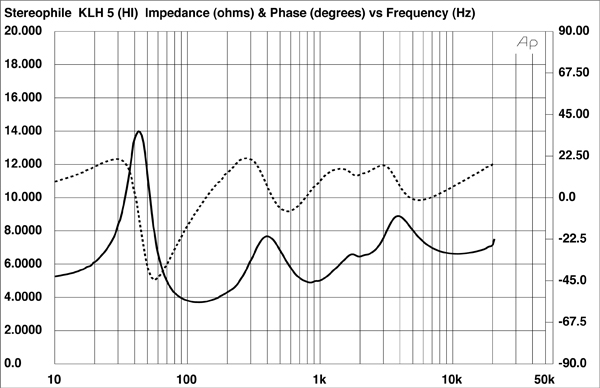
The traces in fig.1 are free from the small discontinuities that would imply that resonances of some kind are present. However, the enclosure seemed lively when I rapped its walls with my knuckles. When I investigated the cabinet's vibrational behavior with a plastic-tape accelerometer, I found a fairly strong resonant mode at 215Hz on the sidewalls and top panel (fig.2) and others at 441Hz and 602Hz on the top and back panels. Even though it has a relatively high Q (Quality Factor), the mode at 215Hz is sufficiently low in frequency and high enough in level that it might add some lower-midrange congestion.
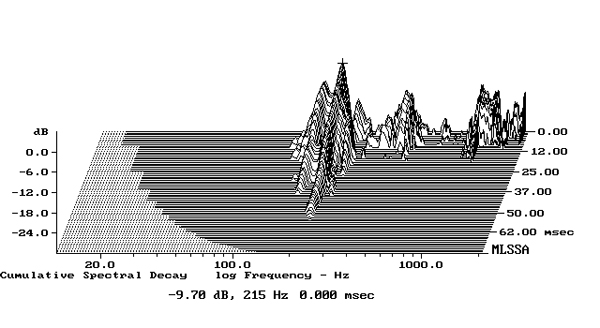
The peak at 42.7Hz in the impedance magnitude trace suggests that this is the tuning frequency of the woofer. As it uses a sealed enclosure, the Model Five's low-frequency response, measured in the nearfield (fig.3, below 300Hz), rolls off with a relatively gentle 12dB/octave slope below the tuning frequency. The peak in the upper bass, which is due to the nearfield measurement technique, is a little higher in amplitude than I usually see.
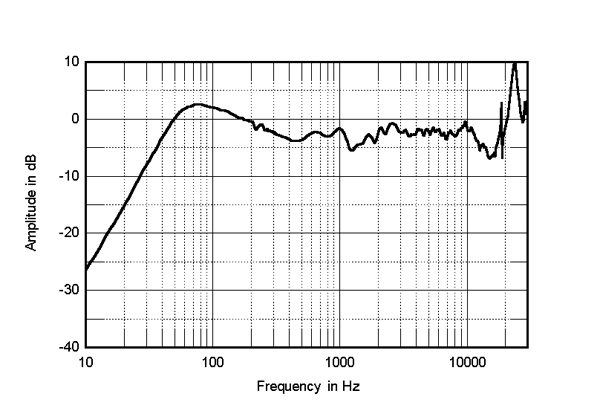
Other than a small drop in energy between 1kHz and 2kHz, the KLH's farfield response, averaged across a 30° horizontal window centered on the tweeter axis (fig.3, above 300Hz), is even up to 10kHz. The tweeter's output rolls off in the top octave before the output rises due to the high-Q, high-amplitude "oil-can" aluminum-dome resonance at 23.7kHz. Another resonance is present a little lower in frequency, at 18.7kHz. This is unusual, so I repeated the measurements on the other sample of the pair, but the resonance was present with that loudspeaker also. I should note the excellent pair matching of the two samples, within 0.5dB in the treble.
Fig.3 was taken without the grille, which I understood from KM was how he had auditioned the Model Fives. Repeating the measurement with the grille reduces the level between 3kHz and 10kHz by up to 3dB. KM also told me that he preferred the Model Five's balance with the Acoustic Balance switch set to HI. Repeating the response measurement shown in fig.3 with the control set to MID reduced the level above 800Hz by 1dB; setting it to LO reduced the treble output by another dB.
Fig.4 shows the Model Five's horizontal dispersion, normalized to the response on the tweeter axis, which thus appears as a straight line. The apparent peak off-axis, indicated by the cursor position, reveals that the lack of energy between 1kHz and 2kHz in the on-axis output tends to fill in to the speaker's sides. The off-axis gulley just below that region suggests that the slight on-axis peak centered on 1kHz becomes smoother off-axis. Experimenting with toe-in will be useful in obtaining the optimal low-treble balance. However, as the relatively wide baffle results in the tweeter's output smoothly rolling off to the sides as the frequency rises, excessive toe-in will make the Model Five sound a little lacking in top-octave air. In the vertical plane (fig.5), the KLH's response doesn't change by much over a ±10° window centered on the tweeter axis.
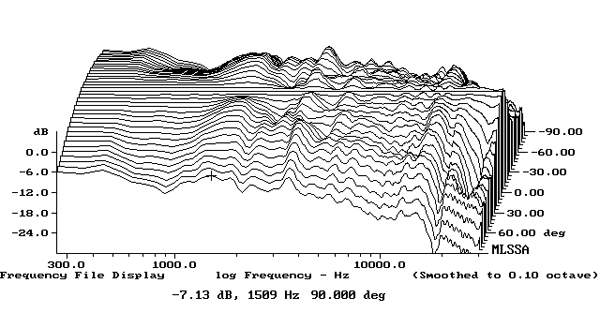
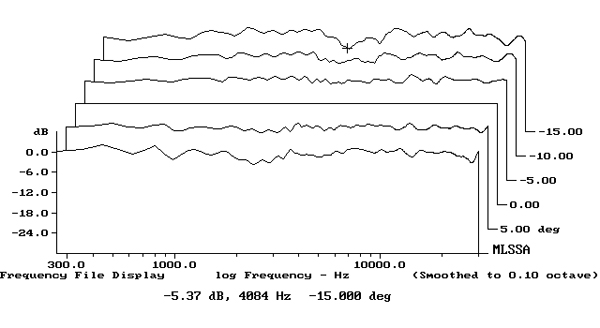
In the time domain, the Model Five's step response on the tweeter axis (fig.6) reveals that the tweeter and midrange unit are connected in inverted acoustic polarity, the woofer in positive polarity. (I confirmed this by looking at the step responses of the individual drive-units.) The decay of the tweeter's step smoothly blends with the negative-going start of the midrange unit's step, which implies optimal crossover design. The decay of the midrange unit's step doesn't quite smoothly blend with the positive-going start of the woofer's step, which implies that the optimum blend will occur just below the tweeter axis. The Model Five's cumulative spectral-decay plot (fig.7) is dominated by the twin tweeter dome resonances at the top of and above the audioband. However, there are some small ridges of delayed energy at 1kHz and between 2kHz and 3kHz.
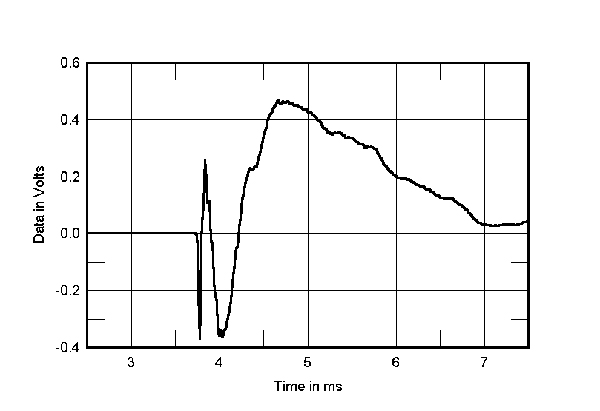
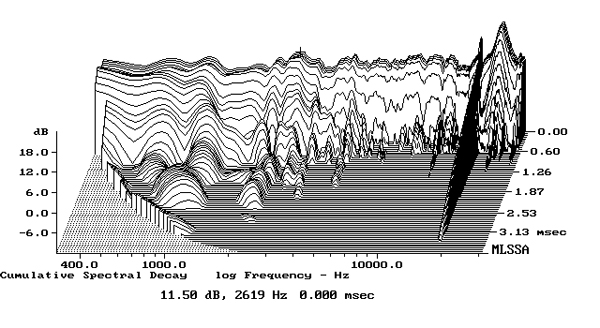
Having never auditioned the original Model Five, I wasn't sure what to expect when I set the new loudspeaker up in the test lab. However, considering its relatively affordable price—$1999.98/pair—the KLH Model Five offers respectable measured performance.—John Atkinson

Thank you!
Now, I gotta find a way to ‘side by side’ these with the Wharfdale Linton speakers. Seems like a perfect shoot out.

... KM do a follow-up review of the Wharfedale and HR do a follow-up review of the KLH.

There is something nice about a box loudspeaker like this, my Operatic mother liked them too ! ( says a lot ).
I sold my Hi-Fi and moved on to Motorcycles, Camping, Engineering School and Marriage with 5 Children! Phew
Later on:
General Motors Corp. sent me to England to re-lamp a Manufacturing Plant with Westinghouse Mercury Vapor Lighting Systems giving me a time budget which I was able to complete about 5 days early, allowing me to meander around London Shops and discover the Rogers LS3/5a in a small hifi specialist. ( I also discovered HiFiNews & Record Review Magazine : the finest Audio publication I'd ever seen ). I purchased Both and still feel like I'd discovered greatness.
As much as I liked my KLH loudspeakers ( enough to purchase them ) I loved ( still do ) the little Rogers and couldn't live without them or their close cousins .
Manufacturing wise :
Business people using Chinese need inform consumers about how impossible it is to get service parts.
Putting Legacy Brand Names on Chinese stuff feels like fraud.
Tony in Venice Florida

... $2K/pair, which would you be more likely to choose:
this new iteration of the KLH Model Five or the equally new (made-in-the-UK by) Falcon LS3/5a Mo(bile)Fi(delity) Edition?
https://falconspeakers.com/products/falcon-ls3-5a-mofi-edition-loudspeakers

I've already been down that road.
I'd buy an eBay pair of one of the many LS3/5a variants, specifically a ProAc Tablette.
or
A used pair of Genelec 8020 with possibly it's matching Subwoofer.
The Big Box design of the KLH and a great many others are probably aimed at Rock folks with a large room.
If I needed to fill a large room, I'd likely do a nice pair of Klipsch or Magnapans.
I have the feeling that these new KLHs scaled up nicely for Mr.Micallef's outstanding Electronic selection and they probably do JAZZ well in his hands.
Tony in Venice Florida
ps. I'd probably turn-down a Garage Sale pair of 5s because I no longer have the Storage space or Wife approval for big boxes of hifi. Class D is calling to me.

Hi
It all depends, bud.
For tiny listening room, minis like Rogers LS3/5a or its crones are the better choice.
But if the room is spacious, then the much larger LH Model 5 would be a better all-rounder high to low frequencies.
I know your concern about made-in-where quality given the same price level.
Me too. I always go for made-in-country-of-origin.
My car for instance: All-Wheel-Drive SUV imported from Japan, its country of origin: better quality control & minimum maintenance.
Jack L


Hi
This I would call "smart business tactic" - to kill 3 birds with one stone" - built in so called 'developing' countries, like China to save cost, lowering selling price to sell more, & making more profit by selling more.
No free lunch, Budd. Inconsistent quality control would result inconsistent performance quality & more frequent repair. Eventually it would backfire to those "legacy brandnames" !
For loudspeakers alone, as long as all electronic components are supplied by the brandname manufacturers & the cabinets & the assembly is made by the OEM off shore should not be so bad.
My qustion is: are the speaker driver units also made by the offhshore OEMs, like China ????? I heard a few brandname loudspeakers speaker units are made in China as well. That's not good news for the consumers !!
Jack L

why not call them AR 3?

Hi
Not all acoustic suspension loudspeakers made & sound equally good.
AR-3a sounded so so much better than AR-3, as per some criitics published. So....
Jack L

Ken, nice review. Except the KLH 9 was not developed by Kloss. That was Arthur Janszen who KLH contracted to build a full range version with his electrostatic driver elements. Janszen's son David continues to design and build speakers under the family name and also restores the long out of production 9s.
Further information provided by David. " In 1957 Arthur designed what would become the 9 and began field tests. In 1959, KLH brought that speaker in for manufacture and began the process of putting it into production, giving my dad a 5 year contract as CTO or something like that plus some stock. This is the one case where Kloss admitted in interviews that he had nothing to do with the design, although I'm sure he helped with the manufacturing engineering."

Dear Mr.Micallef,
I'm sort of puzzled by the various Vinyl Sellers reporting how they came to own large collections of vintage sealed Vinyl.
Recently, Mr.Tupper of the Bronx NY, who collected for 5 to 6 Decades, is now selling to the big Kansas outfit, mostly unplayed and quite rare first pressings, sealed and beautifully preserved. Mr. Tupper reported that he plays Cassettes and has nice Nak Cassette gear. hmm.
The Big Arizona Vinyl Shop also seems to come up with Vinyl Gems. ( presumably pristine and unplayed )
A whole lot of this recent Vinyl "resurgence" appears to be about Collecting impressive numbers of Albums including every Re-master of every popular Artist. Egads, folks seem to amasses tens of thousands of records, probably including a wide range of Duplicates or multiples of Duplicates of exactly the same Album. ( Internet & reviewing personalities will describe their personal collections ) & ( Chad Kassem. seems to limit his customers to only 3 of each of his latest pressings ).
The Jazz Sheppard 'does' play all his Albums ( while alleging that he has never properly cleaned any of them !! , I'll wager that he doesn't even own a Moving Coil or any 'good wire' ). I have him on YouTube Subscription and appreciate the Jazz education he provides.
I can understand the JAZZ lover needing a rather large collection of Blue Note.
I'm asking:
1.) will all those vintage JAZZ recording ever be widely available via streaming ?
2.). Will a 60 Year Old Person ever have enough time to listen to each of his 10,000+++ Albums?
3.) Will anyone inherit Joe Bussard's 78 rpm Collection ?
Thank you for writing for Stereophile, you are always interesting.
Tony in Venice Florida

...cleans his records on my old ProJect machine!! He does indeed play and know his records very well.
People like Chad Kassem and Fred Cohen of Jazz Record Center have been doing this for so many years--they're well jacked-in to the network of buyers and sellers and collectors. But large sealed collections? Never heard of such a thing.
Thank you, Tony.

Tony, I agree it makes sense to consider age VS size of collection and time to play them. I'm older so two years ago when I moved 2,200 miles I sold 2/3rds of my collection. I knew I'd never listen to them all so why pay to move that much weight? However I did go through them all first and it was not always easy to decide which to keep.
Regarding sealed records, a friend had a collection of about 5,000 LPs, many of which were still sealed. When I ask him why he admitted he often would buy 5 to 10 at a time. But then open and play only 2 or 3 before shopping again. With that build up he never got back to opening all the sealed albums.

Hi
This is hoarding, not collecting !
Whatever quantities of LPs one owns, 5 or 5,000 irrespective, the owner should play them to enjoy the music therein.
To show off the 'art' of hoarding or to enjoy the music itself ??
Listening is believing
Jack L